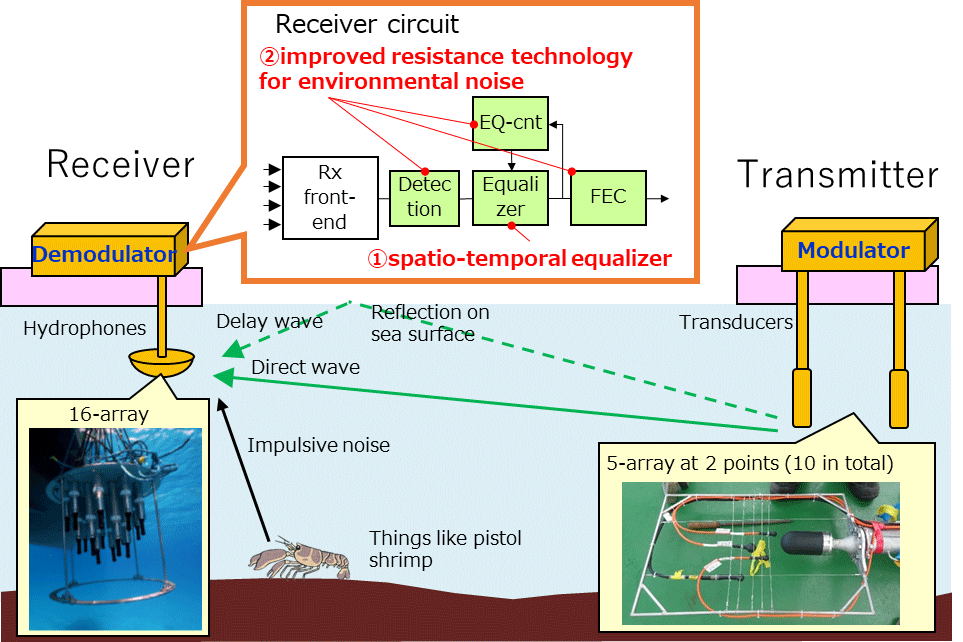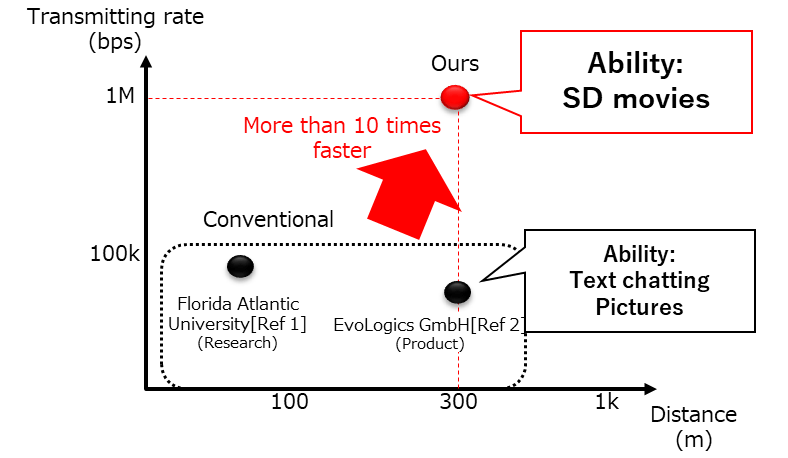Microsoft ends support for Internet Explorer on June 16, 2022.
We recommend using one of the browsers listed below.
- Microsoft Edge(Latest version)
- Mozilla Firefox(Latest version)
- Google Chrome(Latest version)
- Apple Safari(Latest version)
Please contact your browser provider for download and installation instructions.
November 1, 2022
NTT Corporation
NTT DOCOMO, INC.
NTT Communications Corporation
Achieving 1-Mbps/300-m underwater transmission and wireless remotely operated vehicle (ROV) using underwater acoustic communication
- Progress towards the Extreme Coverage Extension that 6G-IOWN is aiming for -
The NTT Corporation (NTT; CEO, Akira Shimada), NTT DOCOMO, INC (DOCOMO; CEO, Motoyuki Ii), and NTT Communications Corporation (NTT Communications; CEO, Toru Maruoka) performed a joint experiment on achieving broadband wireless communication, and we succeeded at 1-Mbps/300-m underwater transmission in a shallow sea area (water depth of about 30 m) using underwater acoustic communication (*1) in field experiments.
These experiments demonstrated the world's first 1-Mbps wireless transmission over 300 m in a shallow sea area using spatio-temporal equalization technology (*2) for broadband transmission and improved resistance technology for environmental noise (*3). In addition, we developed a wireless remotely operated vehicle (ROV) using these technologies.
NTT and DOCOMO started considering applying these technologies to the Non-Terrestrial Network (NTN) (*4) for "5G Evolution & 6G powered by IOWN," and we have started study on extending coverage to underwater areas, which have been unexplored for high-speed wireless communication. In addition, NTT, DOCOMO, and NTT Communications are going to experiment in Shizuoka Prefecture in an underwater equipment inspection using this wireless ROV.
These technologies will be introduced at the "NTT R&D Forum - Road to IOWN 2022" (*5) scheduled to be held from November 16 to 18, 2022.
1. Background
There is demand for high-speed underwater wireless communication, which is one of the unexplored areas targeted by NTN technology. There are plans to realize "ultra-coverage extension" for "5G Evolution & 6G powered by IOWN" that combines the next-generation communication technology 6G with IOWN (*6) technology. Underwater wireless communication is divided into three types: low-frequency electromagnetic field communication that uses radio waves, optical wireless communication that uses light, and acoustic communication that uses sound waves. We focus on acoustic communication that allows for stable long distance transmission in shallow areas, and we have been working to further increase the distance and transmission rate, enabling high-definition underwater video transmission and wireless ROV, which will dramatically improve workability and efficiency in undersea resource development, underwater construction, and fisheries.
2. Introduction of technologies
2.1 Underwater acoustic communication
Fig. 1 shows a diagram of these field experiments. The transmitter has a transducer array with 5 different resonant frequencies (Right picture of Fig. 1) and an acoustic communication modulator. It transmits broadband modulation signals from 10 transducers in total. The receiver has a 16-hydrophone array (Left picture of Fig. 1) and an acoustic communication decoder. It demodulates received signals with the array.
We were successful at the world's first 1-Mbps wireless transmission over 300 m in a shallow sea area with a spatio-temporal equalizer to reduce the impact of delay spread and Doppler effect (*7) with a waving sea surface that are 200,000 times slower than land mobile communication and improved resistance technology for environmental noise to reduce the impact of impulsive noise (*8) from things like a pistol shrimp's impulse wave.
2.2 Positioning of our achievement
Fig. 2 shows the positioning of our achievement. In shallow sea areas, long-distance stable communication is difficult because of the impact of impulsive noise from things like a pistol shrimp's impulse wave. However, our technologies make 1-Mbps/300-m underwater transmission possible. They are more ten times faster than conventional technologies. This is equivalent to the transmission rate required for streaming movies at SD quality (H.264, 480p, 30 fps) and can be applied to real-time degradation diagnosis by transmitting images of underwater equipment and quay walls.
 Fig. 1 Diagram of field experiments
Fig. 1 Diagram of field experiments

Ref 1:P. -P. J. Beaujean, "High-Speed High-Frequency Acoustic Modem for Image Transmission in Very Shallow Waters," OCEANS 2007 - Europe, 2007, pp. 1-6, doi: 10.1109/OCEANSE.2007.4302225.
Ref 2:EvoLogics, "HS communication and positioning devices"
https://evologics.de/acoustic-modem/hs (2022/10/11)
Fig. 2 Positioning of our achievement
3. Wireless ROV
NTT developed a wireless ROV using these technologies. Fig. 3 shows the system for the ROV. The ROV can be controlled on a ship while checking real-time underwater video. The transmitter sends a control signal to the ROV. The ROV moves and shoots on the basis of this control signal and transmits streaming data to the acoustic demodulator on the ship. With this wireless control, the ROV can be operated remotely while real-time underwater video is checked, even in narrow areas with reefs and structures that are difficult to navigate with the conventional tether cable ROV. It is possible to improve the workability and efficiency of underwater facility inspections using underwater drones.
In addition, NTT, DOCOMO, and NTT Communications are going to perform experiments for the "Shizuoka Marine Trial Field Center" (*9) promoted by Shizuoka Prefecture through an underwater equipment inspection using this wireless ROV. The role of each company is as follows:
[Role]
| NTT | Realize wireless ROV with underwater acoustic communication and operate ROV in field experiments. |
|---|---|
| DOCOMO | Investigate applicability of undersea acoustic communication with NTN technology of "5G Evolution & 6G powered by IOWN." |
| NTT Communications | Environmental preparation for experiment implementation in the demonstration field. Evaluation of serviceability with a view to commercialization of undersea wireless communications. |
 Fig. 3 System of wireless ROV
Fig. 3 System of wireless ROV
4. Upcoming
The ROV is expected to be deployed in areas where the conventional tether cable ROV already operates, leading to further expansion of the ROV market. Today, the market for ROV in Japan and overseas is increasing by about 10% annually, but this achievement is expected to further expand the market. NTT Communications is going to work toward practical application in the field of fisheries (for example, marine environment surveys in the aquaculture industry)and to expand the use of underwater drones in other fields such as port facility inspections and the entertainment industry such as diving.
[Notes]
*1Underwater acoustic communication:
This is a technology that applies acoustic communication technology underwater for transmitting information to various devices within the hearing range by superimposing a special sound (trigger sound) that can be communicated with sound emitted from a speaker.
*2Spatio-temporal equalization technology:
This technology suppresses the deterioration in communication quality due to waves reflected from the sea surface by suppressing part of the reflected waves from the sea surface and the seabed in the spatial domain using array technology that uses multiple receivers.
Reference: IEICE Communications Society Magazine, 2022, vol. 15, issue 4, pp. 284-297
"Emerging Technology Papers: Spatio-Temporal Equalization Technology for High-Speed Underwater Acoustic Communications"
https://www.jstage.jst.go.jp/article/bplus/15/4/15_284/_article/-char/en
*3Improved resistance technology for environmental noise:
A technology that suppresses characteristic deterioration caused by environmental noise, such as the plosive sounds generated by pistol shrimp, sailing sounds of ships, and working noises of heavy machinery used in coastal facilities, which are frequently observed in shallow water areas at depths of several tens of meters.
Reference: NIKKEI Business Communication, 2022, vol. 59, no. 9, pp. 26-29
"Further Evolution of 'Spatio-Temporal Equalization Technology' to Achieve High-Speed Underwater Acoustic Communication"
https://www.bcm.co.jp/site/2022/09/mirai-net/2209-mirai-net-01-03.pdf
*4Non-Terrestrial Network (NTN):
This is a network that uses non-terrestrial media such as satellites and HAPS to extend the communication area not only on the ground but also in the air, sea, and space.
*5NTT R&D Forum 2022 Road to IOWN
URL: https://www.rd.ntt/e/forum/
*6IOWN:
Technology development roadmap for realizing the IOWN concept
https://group.ntt/en/newsrelease/2020/04/16/200416a.html
*7Doppler effect:
When an object that emits waves such as sound or light moves, this phenomenon occurs in which the frequency shifts due to the relative speed difference between the transmitting side and the receiving side. When approaching, the wavelength is compressed, and the frequency increases; when moving away, the wavelength is stretched, and the frequency decreases.
*8Impulsive noise:
This is noise that occurs suddenly in time and frequency. In underwater acoustic propagation in shallow sea areas, it corresponds to the plosive sound generated by the pistol shrimp.
*9Shizuoka Marine Trial Field Center:
This is a one-stop service provided by the Incubate & Promote New Industry Organization of the Shizuoka Chamber of Commerce & Industry for conducting various demonstration experiments and PoC for the promotion of the marine industry and conservation of the marine environment. For details, please refer to the website of the Incubate & Promote New Industry Organization below.
https://www.nio-s.net/fieldc/index.html
For inquiries regarding this matter, please contact
NTT Corporation
Public Relation Officer, Science and Core Technology Laboratory Group
nttrd-pr@ml.ntt.com
NTT DOCOMO, INC.
6G-IOWN Promotion Department
6gi-strategy@ml.nttdocomo.com
NTT Communications Corporation
PR Office
pr-cp@ntt.com
Information is current as of the date of issue of the individual press release.
Please be advised that information may be outdated after that point.
NTT STORY
WEB media that thinks about the future with NTT











